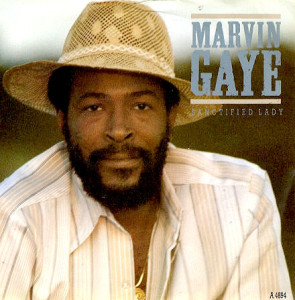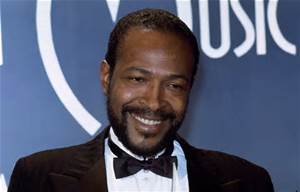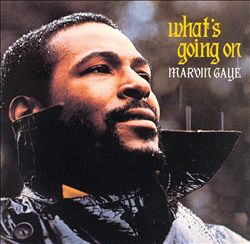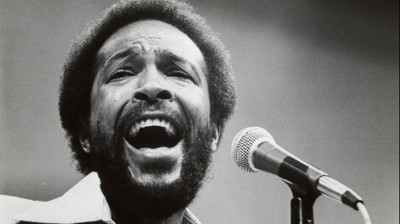
Marvin Gaye
Gaye started singing in church when he was four years old; his father often accompanied him on piano. Gaye and his family were part of a Pentecostal church known as the House of God. The House of God took its teachings from Hebrew Pentecostalism, advocated strict conduct, and adhered to both the Old and New Testaments. Gaye developed a love of singing at an early age and was encouraged to pursue a professional music career after a performance at a school play. His home life consisted of “brutal whippings” by his father, who struck him for any shortcoming. The young Gaye described living under his father’s house as similar to “living with a king, a very peculiar, changeable, cruel and all powerful king”.[7] He felt that had his mother not consoled him, and encouraged his singing, he would have killed himself.His sister later explained that Gaye was beaten often, from age seven well into his teenage years.
Gaye attended Cardozo High School and joined several doo-wop vocal groups, including the Dippers and the D.C. Tones. Gaye’s relationship with his father worsened during his teenage years as his father would kick him out of the house for what he perceived was misbehavior. Following an argument in which he stood up against his father, Gaye walked out of the house for good and dropped out of high school.[19] With dreams of being a pilot, 17-year-old Gaye enlisted in the United States Air Force as a basic airman.Disappointed in having to perform menial tasks, he faked mental illness and was discharged shortly afterwards.[22] Gaye’s sergeant stated that he refused to follow orders.
Career
Early career
A 1959 promotional picture of Harvey and the “New Moonglows”. Gaye is located fourth from the left behind a seated Fuqua.
Following his return, Marvin and good friend Reese Palmer formed the vocal quartet The Marquees.The group performed in the D.C. area and soon began working with Bo Diddley, who assigned the group to Columbia subsidiary OKeh Records after failure to get the group signed to his own label, Chess. The group’s sole single, “Wyatt Earp”, failed to chart and the group was soon dropped from the label. Marvin began composing music during this period.[26] The Marquees were later hired by Moonglows co-founder Harvey Fuqua as his employees. Under Fuqua’s direction, the group changed its name to Harvey and the “New Moonglows” relocating them to Chicago.[28] The group recorded several sides for Chess in 1959, including the song “Mama Loocie”, which was Marvin’s first lead vocal recording. The group found work as session singers for established acts such as Chuck Berry, singing on the hits “Back in the U.S.A.” and “Almost Grown”. In 1960, the group disbanded and Marvin relocated to Detroit with Fuqua where he signed with Tri-Phi Records as a session musician, playing drums on several Tri-Phi releases. Marvin performed at Motown president Berry Gordy’s house during the holiday season in 1960. Impressed by the singer, Gordy sought Fuqua on his contract with Marvin. Fuqua agreed to sell part of his interest in his contract with Gaye. Shortly afterwards, Marvin signed with Motown subsidiary Tamla.
When Marvin signed with Tamla, he pursued a career as a performer of jazz music and standards, having no desire to become an R&B performer. Before the release of his first single, Marvin was teased about his surname, with some jokingly asking, “Is Marvin Gay?” Marvin changed his surname by adding an “e”, following the style of Sam Cooke. Author David Ritz wrote that the move was to silence rumours of his sexuality while adding the move also was designed to bring more distance between Marvin and his father. Gaye released his first single, “Let Your Conscience Be Your Guide” in May 1961, with the album, The Soulful Moods of Marvin Gaye, following a month later. Gaye’s initial recordings were flops. Gaye spent most of 1961 performing session work as a drummer for artists such as The Miracles and The Marvelettes and was being paid $5 (US$39 in 2014 dollars) a week playing drums for the Miracles and blues artist Jimmy Reed. While Gaye would take some advice on performing with his eyes open (having been accused of appearing as though he were sleeping), Gaye refused to attend grooming school courses at the John Roberts Powers School for Social Grace in Detroit because of his unwillingness to comply with its orders, something he later regretted.
Initial success
In 1962, Gaye found success as co-writer of the Marvelettes hit, “Beechwood 4-5789”. His first solo hit, “Stubborn Kind of Fellow”, was later released that September, reaching number 8 on the R&B chart and number 46 on the Billboard Hot 100. Gaye reached the top 50 with the dance song, “Hitch Hike”, peaking at number 30 on the Hot 100. “Pride and Joy” became Gaye’s first top ten single after its release in 1963. The three singles and songs from the 1962 sessions were included on Gaye’s second album, That Stubborn Kinda Fellow. Starting in October of the year, Gaye performed as part of the Motortown Revue, a series of concert tours headlined at the north and south eastern coasts of the United States as part of the chitlin’ circuit. A filmed performance of Gaye at the Apollo Theater took place in June 1963. Later that October, Tamla issued the live album, Marvin Gaye Recorded Live on Stage. “Can I Get a Witness” became one of Gaye’s early international hits.
In 1964, Gaye recorded a successful duet album with singer Mary Wells titled Together, which reached 42 on the pop album chart. The album’s two-sided single, including “Once Upon a Time” and “What’s the Matter With You Baby”, each reach the top 20. Gaye’s next solo hit, “How Sweet It Is (To Be Loved By You)”, written for Gaye by Holland-Dozier-Holland, reached number 6 on the Hot 100 and reached the top 50 in the UK. Gaye started getting some TV exposure around this time on shows such as American Bandstand. Also in 1964, he appeared in the concert film, The T.A.M.I. Show. Gaye had two number one R&B singles in 1965 with the Miracles-composed “I’ll Be Doggone” and “Ain’t That Peculiar”. Both songs became million-sellers.
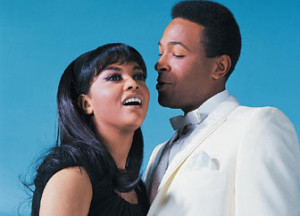
A screenshot of a 1967 performance by Gaye and Terrell during taping of the Today Show.
After scoring a hit duet, “It Takes Two” with Kim Weston, Gaye began working with Tammi Terrell on a series of duets, mostly composed by Ashford & Simpson, including “Ain’t No Mountain High Enough”, “Your Precious Love”, “Ain’t Nothing Like the Real Thing” and “You’re All I Need to Get By”.
“I Heard It through the Grapevine”
“I Heard It through the Grapevine” was recorded by Gaye in April 1967, several months before Gladys Knight and the Pips recorded it. The song features a horror-based Wurlitzer piano solo, percussion, and horns. Gaye’s recording of it paved the way for what later became “psychedelic soul”.
Problems playing this file? See media help.
In October of the year 1967, Terrell collapsed in Gaye’s arms during a performance in Farmville, Virginia. Terrell was subsequently rushed to Farmville’s Southside Community Hospital, where doctors discovered she had a malignant tumour in her brain.
The diagnosis ended Terrell’s career as a live performer, though she continued to record music under careful supervision. Despite the presence of hit singles such as “Ain’t Nothing Like the Real Thing” and “You’re All I Need to Get By”, Terrell’s illness led to problems with recording with repeated operations to remove the tumor. Gaye was reportedly devastated by Terrell’s sickness and became disillusioned with the record business. In late 1968, Gaye’s recording of “I Heard It Through the Grapevine” was released and became Gaye’s first to reach number one on the Billboard Hot 100; it also reached the top of the charts in other countries, selling well over four million copies. However, Gaye felt the success was something he “didn’t deserve” and that he “felt like a puppet—Berry’s puppet, Anna’s puppet….” Gaye followed it up with “Too Busy Thinking About My Baby” and “That’s the Way Love Is”, which reached the top ten on the Billboard Hot 100 in 1969. That year, his album M.P.G. became his first number one R&B album. Gaye produced and co-wrote two hits for The Originals during this period, including “Baby I’m For Real” and “The Bells”.
On March 16, 1970, Tammi Terrell died from brain cancer, and Gaye attended her funeral. Following this, he went into prolonged seclusion from the music business. After a period of depression, Gaye sought out a position on a professional football team, the Detroit Lions, where he later befriended Mel Farr and Lem Barney.[43] It was eventually decided that Gaye wouldn’t be allowed to try out owing to fears of possible injuries that could have affected his music career.
What’s Going On and subsequent success
Main articles: What’s Going On (Marvin Gaye album) and Let’s Get It On
Gaye performing live at the Oakland Coliseum on January 4, 1974 during his comeback 1974–75 tour.
On June 1, 1970, Gaye returned to Hitsville U.S.A., where he recorded his new composition “What’s Going On”, inspired by an idea from Renaldo “Obie” Benson of the Four Tops after he witnessed an act of police brutality at an anti-war rally in Berkeley.[46] Upon hearing the song, Berry Gordy refused its release due to his feelings of the song being “too political” for radio. Gaye responded by going on strike from recording until the label released the song. Released in 1971, it reached number one on the R&B charts within a month, staying there for five weeks. It also reached the top spot on Cashbox’s pop chart for a week and reached number two on the Hot 100 and the Record World chart, selling over two million copies.
After giving an ultimatum to record a full album to win creative control from Motown, Gaye spent ten days recording the What’s Going On album that March.[50] Motown issued the album that May after Gaye remixed portions of the album in Hollywood.The album became Gaye’s first million-selling album launching two more top ten singles, “Mercy Mercy Me (The Ecology)” and “Inner City Blues”. One of Motown’s first autonomous works, its theme and segue flow brought the concept album format to rhythm and blues and was later cited by an Allmusic writer as being “the most important and passionate record to come out of soul music, delivered by one of its finest voices”.[51] For the album, Gaye received two Grammy Award nominations and several NAACP Image Awards.The album also topped Rolling Stone’s year-end list as its album of the year. Billboard magazine named Gaye Trendsetter of the Year following the album’s success. In 1971, Gaye signed a new deal with Motown worth $1 million (US$5,823,336 in 2014 dollars[31]), making it the most lucrative deal by a black recording artist at the time. Gaye first responded to the new contract with the soundtrack and subsequent score, Trouble Man, released in late 1972.
“Let’s Get It On”
“Let’s Get It On” was written by Gaye and producer Ed Townsend, originally as a gospel song, and later as a protest song before eventually turning into a funk-oriented love anthem. It became Gaye’s second number-one hit in 1973.
Problems playing this file? See media help.
In 1973, Gaye released the Let’s Get It On album. Its title track became Gaye’s second number one single on the Hot 100. The album subsequently stayed on the charts for two years and sold over three million copies. The album was later hailed as “a record unparalleled in its sheer sensuality and carnal energy.” Other singles from the album included “Come Get to This”, which recalled Gaye’s early Motown soul sound of the previous decade, while the suggestive “You Sure Love to Ball” reached modest success but received tepid promotion due to the song’s sexually explicit content. Marvin’s final duet project, Diana & Marvin, with Diana Ross, garnered international success. Responding to demand from fans and Motown, Gaye started his first tour in four years at the Oakland-Alameda County Coliseum on January 4, 1974. The performance received critical acclaim and resulted in the release of the live album, Marvin Gaye Live! and its single, a live version of “Distant Lover”, an album track from Let’s Get It On.
The tour helped to increase Gaye’s reputation as a live performer.[56] For a time, he was earning $10,000 a night (US$47,821 in 2014 dollars) for performances.Gaye toured throughout 1974 and 1975. A renewed contract with Motown allowed Gaye to build his own custom-made recording studio. In October 1975, Gaye gave a performance at a UNESCO benefit concert at New York’s Radio City Music Hall to support UNESCO’s African literacy drive, resulting in him being commended at the United Nations by then-Ambassador to Ghana Shirley Temple Black and Kurt Waldheim. Gaye’s next studio album, I Want You, followed in 1976 with the title track becoming a number-one R&B hit. That summer, Gaye embarked on his first European tour in a decade, starting off in England. In early 1977, Gaye issued the live album, Live at the London Palladium, which sold over two million copies thanks to the success of its studio song, “Got to Give It Up”, which became a number one hit.
Last Motown recordings and European exile
Main articles: Here, My Dear and In Our Lifetime (Marvin Gaye album)
In December 1978, Gaye issued Here, My Dear, inspired by the fallout of his first marriage to Anna Gordy. Recorded as an intent for Gaye to remit a portion of its royalties to her to receive alimony payments, it flopped on the charts.[60] During that period, Gaye developed a serious dependence and addiction to cocaine and was dealing with several financial issues with the IRS. These issues led him to move to Maui, where he struggled to record a disco album. In 1980, Gaye went on a European tour. By the time the tour stopped, the singer relocated to London where he feared imprisonment for failure to pay back taxes, which had now reached upwards of $4.5 million.(US$12,880,250 in 2014 dollars
Gaye then reworked Love Man from its original disco concept to another personal album invoking religion and the possible end time from a chapter in the Book of Revelation. Titling the album, In Our Lifetime?, Gaye provided work on the album for much of 1980 in London studios such as Air and Odyssey Studios. In the fall of that year, a master tape of a rough draft of the album was stolen from one of Gaye’s traveling musicians, Frank Blair, who took the master tape to Motown’s Hollywood headquarters. Motown remixed the album and issued it on January 15, 1981.[67] When Gaye learned of its release, Gaye accused Motown of editing and remixing the album without his consent, allowing the issue of an unfinished production (“Far Cry”), altering the album art of his request and removing the album title’s question mark, muting its irony. He also accused the label of rush-releasing the album, comparing his unfinished album to an unfinished Picasso painting. Gaye then promised not to record any more music for Motown.
On February 14, 1981, under the advice of music promoter Freddy Cousaert, Gaye relocated to Cousaert’s apartment in Ostend, Belgium. While there, Gaye shied away from heavy drug use and began exercising and attending a local Ostend church, regaining personal confidence. Following several months of recovery, Gaye sought a comeback onstage, starting the short-lived Heavy Love Affair tour in England and Ostend between June and July 1981. Gaye’s personal attorney Curtis Shaw would later describe Gaye’s Ostend period as “the best thing that ever happened to Marvin”. When word got around that Gaye was planning a musical comeback and an exit from Motown, CBS Urban president Larkin Arnold eventually was able to convince Gaye to sign with CBS. On March 23, 1982, Motown and CBS Records negotiated for Gaye to be released from Motown. The details of the contract were kept from being revealed due to a possible negative effect on the singer’s settlement to creditors from the IRS.
Midnight Love
Main articles: Midnight Love and Sexual Healing
“Sexual Healing”
“Sexual Healing” was written by Gaye alongside Odell Brown and David Ritz. Ritz said Gaye advised him to write a poem after telling the singer he needed “sexual healing” while living in Europe. The song became an international hit after its release in 1982.
Problems playing this file? See media help.
Assigned to CBS’ Columbia subsidiary, Gaye worked on his first post-Motown album titled Midnight Love. The first single, “Sexual Healing”, was released on September 30, 1982, and became Marvin’s biggest career hit, spending a record ten weeks at number one on the Hot Black Singles chart, becoming the biggest R&B hit of the 1980s according to Billboard stats. The success later translated to the Billboard Hot 100 chart in January 1983 where it peaked at number three, while the record reached international success, reaching the top spot in New Zealand and Canada and reaching the top ten on the United Kingdom’s OCC singles chart, later selling over two million copies in the US alone, becoming Gaye’s most successful single to date. The video for the song was shot at Ostend’s Casino-Kursaal.”Sexual Healing” won Gaye his first two Grammy Awards including Best Male R&B Vocal Performance, in February 1983, and also won Gaye an American Music Award in the R&B-soul category. It was called “America’s hottest musical turn-on since Olivia Newton John demanded we get ‘Physical'” by People magazine. Midnight Love was released to stores a day after the single’s release and was as successful as the single, peaking at the top ten of the Billboard 200 and becoming Gaye’s eighth number-one album on the Top Black Albums chart, eventually selling over six million copies worldwide, three million alone in the United States.
“ I don’t make records for pleasure. I did when I was a younger artist, but I don’t today. I record so that I can feed people what they need, what they feel. Hopefully, I record so that I can help someone overcome a bad time. ”
NME – December 1982
On February 13, 1983, Gaye performed “The Star-Spangled Banner” at the NBA All-Star Game, held at The Forum in Inglewood, California, accompanied by Gordon Banks, who played the studio tape from stands. The following month, Gaye performed at the Motown 25: Yesterday, Today, Forever special. This and a May appearance on Soul Train, his third appearance overall on the show, became Gaye’s final television performances. Gaye embarked on his final concert tour, titled the Sexual Healing Tour, on April 18, 1983 in San Diego, California. The tour ended on August 14, 1983 at the Pacific Amphitheatre in Costa Mesa, California but was plagued by cocaine-triggered paranoia and illness. Following the concert’s end, he retreated to his parents’ house in Los Angeles. In early 1984, Midnight Love was nominated for a Grammy in the Best Male R&B Vocal Performance category, his fourteenth and final nomination.
Death
Main article: Death of Marvin Gaye
At around 11:38 am (PST) on April 1, 1984, as Marvin was seated on his bed talking to his mother, Gaye’s father shot Marvin twice. The first shot, which entered the right side of Gaye’s chest, was fatal, having perforated his vital organs. Gaye was taken to the emergency room of the California Hospital Medical Center and was pronounced dead on arrival at 1:01 pm (PST).Gaye died a day before turning 45. The gun with which Marvin Gaye, Sr. shot his son was given to him by Marvin as a Christmas present.
Following his funeral, Marvin was cremated with part of his ashes spread near the Pacific Ocean. Gaye did not leave behind a will or an insurance policy at the time of his death. Gaye’s father pleaded no contest to a voluntary manslaughter charge and was sentenced to probation. He later died of pneumonia in 1998. Marvin’s fans have held vigils for the singer at the final residence to celebrate the day of his birth.



